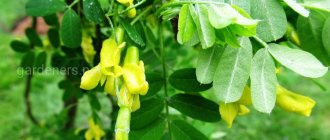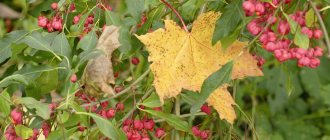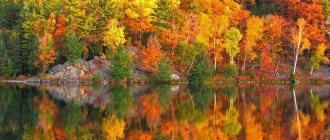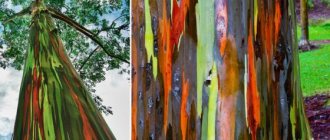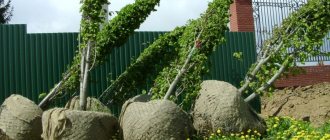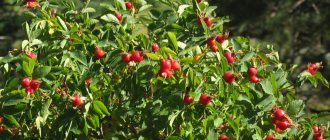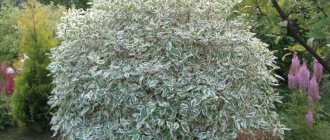Have you ever selected seedlings for your garden with an eye to their decorative value in winter? We offer you a selection of trees and shrubs that will color the most gray and faded landscape.
Winter doesn't have to be synonymous with a boring, gray garden! With the right selection of trees and shrubs, your personal corner of wildlife can sparkle with a rich variety of colors and textures.
Take note of our list!
Useful birch Jacquemont (Betula utilis var. Jacquemontii)
Useful birch variety Jacquemman, or simply Himalayan birch, as it is often called in everyday life, is perhaps the snow-white birch in the world! Its bark finally turns white in the sixth year of life. Thanks to this feature in winter, especially in a light snow coat, it looks, without exaggeration, fabulous.
Considering that the homeland of this plant is the Himalayas, it feels great in the most severe frosts. This birch loves good light, but can also tolerate partial shade. Grows best in well-moistened but drained soils. If your site is located in a lowland, you should take care of water drainage.
Himalayan birch grows relatively slowly. The height of the tree reaches 9-12 m, the width of the crown does not exceed 5-7 m. It is a multi-stemmed crop. The branches are directed upward and do not “scatter” like a fan.
Jacquemman birches look especially impressive in group plantings. They can be used to create mixborders and alleys. Himalayan birch trees can be planted along the fence. And in winter, your site will be edged with the finest lace of snow-white branches.
My tricks for growing ornamental shrubs in unfavorable conditions
The soil on the plot is loamy, it’s hard to call it fertile (outside the vegetable growing zone): on both sides of the plot, right behind the fence, huge old poplars grow. Their roots grow wherever there is even a hint of food. They also suck out water.
Therefore, mulch of grass and weeds serves as plant nutrition. It also conserves moisture at the roots. Sometimes the bushes get ash from the barbecue, but rarely: all the best goes to the roses.
Mulch keeps the soil loose and moist, greatly inhibits the growth of weeds and prevents soil loosening. A kind of lifesaver for a busy (work, home, family) woman. I recommend!
Serrated cherry (Prunus serrula)
Serrata cherry, a close relative of sakura, is also known among gardeners as Tibetan cherry. This decorative tree is attractive with its shoots and trunk in a luxurious mahogany shade. The bark is glossy, shiny, densely dotted with streak-like lentils.
Tibetan cherry is a multi-stemmed tree with a branched crown. In adulthood, its height and crown diameter are approximately equal and reach 6-9 m.
This type of cherry is truly unpretentious: it grows well in different types of soil, but especially prefers those rich in humus. Like other members of the family, the tree needs good lighting and watering; it does not like stagnant water in the area.
The plant is frost-resistant and withstands midland winters with dignity. In addition, this cherry tree does not require complex care or radical pruning.
Serrated cherry looks magical not only in spring during flowering, but also in winter thanks to the bright color of the shoots. And in summer and autumn it is decorated with glossy dark green foliage.
The fruits of the Himalayan cherry can theoretically be eaten raw, but in fact their taste is too specific and not very pleasant. Most often, the berries are used in folk medicine.
Chubushnik
Crown mock orange (Philadelphus coronarius) is another fragrant happiness. During flowering, I want to somehow organize my existence near this bush. Beautiful pictures in catalogs and tempting descriptions made my head spin, and I kept trying to breed Lemoine mock oranges . Unsuccessfully - both ' Dame Blanche' and ' Schneesturm' . The Vekhovskys were not caught.
While I was looking for the ideal mock orange for our difficult climatic conditions, a wild mock orange seedling grew in a thorny Japanese quince bush. Apparently, something flew in from a neighbor's large bush of a long-forgotten variety. The neighbors' thickets were very successfully located almost close to the foundation on the south side of the house, and, sheltered from the prevailing winds by the garage, they felt quite comfortable.
I placed the seedling on the southwest side, where there is more sun and a lot of snow in winter. An abundance of sun is a guarantee of lush flowering. During the first winters, I wrapped him in a double layer of thick spunbond; as he grew older, he began to spend the winter in the snow. Young immature shoots freeze out in all cases of “black frost”. That is, if in the absence of snow the temperature drops below -20 °C. All shoots overwinter depending on the snow level. The mock orange blossomed in the 3rd year and increases flowering every year.
Read our detailed material about the plant Chubushnik - the king of unpretentious shrubs.
Crown mock orange (Philadelphus coronarius). © Tatyana Nikolina
Heptacodium miconioides
Heptacodium myconium has many wonderful names: northern myrtle, German rhododendron, and autumn lilac. But best of all, its appearance reflects the nickname that people gave to the plant - the flower of seven sons.
The thing is that heptacodium inflorescences are collected in lush paniculate brushes of 7 pieces. During flowering, they are strewn with snow-white flowers, and at the end they acquire a dark pink color - this is the color of the sepals in which the purple fruits are “hidden”. It is the faded heptacodiums that resemble lilac or rhododendron bushes.
The flowering period falls at the end of summer - beginning of autumn. At this time, the corner of the garden occupied by heptacodium is filled with a pleasant sweet aroma, somewhat reminiscent of the smell of climbing honeysuckle Honeysuckle, and butterflies flutter around the fragrant bush.
We are interested in the appearance of this little-known shrub in our area in winter. Pink brushes last until the very first frost. But even without such elegant decoration, heptacodium attracts attention. Its shoots are covered with exfoliating bark of a grayish-barley hue, very similar to the bark of a plane tree.
The culture can be formed not only as a shrub, but also as a small tree. Heptacodiums formed on three trunks look the most beautiful. An adult plant grows up to 3-5 m.
This ornamental plant has “won” the recognition of many fans in Canada and the USA, and has also managed to gain popularity in Western Europe. It is quite possible to grow it not only in the Moscow region, but also in the middle zone - according to breeders, heptacodiums should tolerate frosts down to -29°C.
Heptacodiums are planted in well-lit areas protected from the wind.
Shrubs for cold regions
Frost-resistant ornamental flowering shrubs thrive in cold regions of the country.
Syringa
Mock orange or garden jasmine grows well in climate zones 2 and 3. Tall varieties of perennials can reach three meters in height, while low-growing varieties do not exceed 100 cm.
Most plants have erect, twig-like shoots, but there are twining and drooping ones. The flowers have a regular shape, often collected in clusters.
Jasmine grows well in shade and sunlit areas of the garden. But summer residents say that the aroma is brighter in shaded areas.
Mock orange needs additional watering only in severe drought. It responds to feeding with abundant flowering. Weeding, loosening the soil and pruning are performed as necessary.
Derain white
Another name for the shrub is variegated derain. One of the most popular perennial plants for the northern garden. The central stems grow upright, the lateral ones bend towards the ground. In nature, the shrub can reach 3 meters in height.
Flowering begins in May-June - small creamy-yellow flowers densely cover the bush. In winter, the foliage turns burgundy.
Derain is unpretentious in care. Grows in shaded and sunny places, on any soil. Frost-resistant, does not require shelter for the winter. To be on the safe side, young bushes can be covered with a thick layer of snow. Every 2 years the bush is pruned to preserve the brightness of the bark.
Snowberry white
Of the 15 species of this flowering shrub, only white snowberry has adapted to the harsh climatic conditions of Russia. The plant can withstand temperatures as low as -35 °C without shelter.
The height of the ornamental plant for the garden is 1.5 meters. The shoots are flexible, the leaves are small and elliptical in shape. The flowers are small, bell-shaped, pale pink or white. Flowering begins in the second half of summer and lasts about a month. At the beginning of autumn, snow-white fruits with a diameter of about 1 cm appear on the snowberry patch. The fruits hold tightly to the branches even in winter under a layer of snow.
The fruits of the snowberry are beautiful, but poisonous. They cannot be eaten.
The shrub is drought-resistant - in hot summers it is enough to water it once a week. In spring, you can prune damaged shoots and give flowering bushes a neater shape.
Barberry
Heat-resistant and frost-resistant perennial barberry is beautiful during the flowering period and in the fall, when the fruits appear and the leaves acquire red and yellow shades.
Depending on the species, barberry can be deciduous or evergreen. The height of the plant ranges from 60 to 250 cm. The shoots are ribbed and erect. The leaves are small in size, growing on short petioles in bunches of 3-6 pieces. Yellow flowers form clusters of 6-10 buds. They bloom in May. The fruits ripen in September.
Agricultural technology for barberry is standard - weeding, loosening and watering are carried out as necessary. There is no need to cover barberry for the winter. Pruning and crown formation are carried out in the spring months.
Bladderwort viburnum
This flowering perennial shrub comes in two forms - with purple and with golden leaves. Plant height up to three meters. The shape is fountain-shaped and spreading. The leaves are large.
Flowering begins in June and lasts until August. The buds are small, white, the inflorescences are collected in “caps”. After flowering, fruits appear in the form of bubbles. At first they are green, and in the fall they turn dark burgundy.
Bladderwort is an unpretentious flowering shrub. Loves the sun, but grows well in the shade. Frost-resistant, does not require shelter for the winter. Crown pruning is performed in early spring, removing old, damaged and diseased branches. Decorative molding can be done from the age of 3.
Every 5 years, the bladderwort is cut off almost at the root, leaving 20-centimeter stumps.
Spirea
There are many varieties of spirea. There are both low-growing (15 cm) and tall (up to 2.5 m) perennials. Branches can be erect, spreading, recumbent or creeping. The inflorescences are pyramidal, paniculate, corymbose or spike-shaped and consist of small flowers.
The color range is varied - from snow-white to crimson. In different species, inflorescences can be concentrated in different places - at the ends of branches, in the upper part, along the entire stem.
Spiraea can be spring-blooming or summer-blooming. Most spireas grow in both sunny and shaded areas. The flowering bush is winter-hardy and does not require shelter even in the Siberian winter.
Spiraea loves frequent but moderate watering and nutritious soil. For fertilizing, both complex mineral fertilizers and manure fertilizers with the addition of superphosphate are used. Mandatory measures for caring for a flowering bush are loosening and pulling out weeds.
White dogwood (Cornus alba)
White dogwood (or white dogwood) is a favorite plant in autumn and winter mixborders. Its cherry-red shoots will add bright accents to a “dormant” garden. For example, we have already offered the option of a beautiful flower garden with dogwood, heather, Erica and herbs.
In one season, this shrub changes its “outfit” several times. In late spring and summer, it is “dressed” in green and white: the foliage is strewn with small brushes with a diameter of 5 cm, collected from tiny whitish-cream inflorescences. In autumn the leaves turn yellow, and the deren greets the arrival of winter in a red “suit”.
The fruits of this tree ripen in mid-summer. They are usually white, but in some varieties they take on a bluish-blue tint.
Sometimes white derain blooms again in the summer.
The bush will not give you any trouble: it does not get sick, is not afraid of frost, drought and slight flooding.
The height of an adult plant is 2.4-3 m.
It is worth considering that pruning the tree depends on your plans for its participation in the garden “symphony”. If you want to achieve maximum showiness in winter, you need to encourage the bush to branch. To do this, cut a third of the old shoots to the ground in early spring. If you want the turf to bloom and bear fruit, do not prune young shoots.
There are various cultivars of white dogwood. The most popular of them are Elegantissima, which is notable for its green foliage with a white border, Aurea with golden leaves, Sibirica with bluish fruits.
Winter-hardy shrubs for the garden, blooming all summer: main groups
Flowering shrubs at the dacha can make the area as beautiful and cozy as possible. With their help, fragrant gardens are created in the recreation area. In addition, most plants belonging to this group cope well with frost and are distinguished by a variety of colors. They begin to bloom in early spring and end in late autumn. But even with the arrival of winter, these plants do not lose their decorative value and continue to act as the main decoration of flower beds.
When choosing shrubs, it is important to take into account not only the climatic conditions under which they are able to quickly and actively develop, but also their main purpose. They can be used in mixborders, planted on lawns, in rock gardens or rockeries, or as a hedge. Depending on this, individual crop varieties are selected, which are divided into the following main groups:
- highly frost-resistant;
- frost-resistant;
- moderately frost-resistant;
- least resistant to frost.
Very frost-resistant shrubs
Yellow acacia
They can withstand fairly low temperatures down to -50 degrees below zero. Such shrubs include: red elderberry, scarlet hawthorn, yellow acacia, mountain pine.
Frost-resistant
Kalina
This group includes plants that can cope with air temperatures down to -35 degrees below zero. The following varieties will withstand this temperature perfectly: common hawthorn, red viburnum, wrinkled rose, western thuja.
Moderately frost-resistant
Japanese quince
Able to cope with frosts down to -25 degrees. Such shrubs include: cherry laurel with boxwood, Japanese quince, deutzia and spirea.
Red dogwood (Cornus sanguinea)
Another variety of svidina is blood-red (an alternative name is red derain). This shrub, like its “brother,” boasts a luxurious red tint of shoots. True, in his case the color often becomes more reddish, almost orange.
In summer, the foliage of this tree is rich green, and by autumn it acquires a purple-orange hue. The inflorescences, like those of the previous type of tree, are white. These two varieties can be distinguished by their fruits - the blood-red ones are bluish-black, almost inky.
An adult shrub reaches a height and width of up to 1.5-1.8 m. It is unpretentious to the type of soil and is not susceptible to diseases. It is best to plant it in partial shade or in areas with diffused light.
Red dogwood is ideal for creating hedges and mixborders.
The principle of pruning this plant is the same as in the case of white dogwood. It is not necessary to carry it out, but to stimulate the formation of new shoots, 1/3 of the old branches are cut into a ring every spring.
Popular varieties of blood-red derene are Magic Flame and Midwinter Fire.
Wind-resistant shrubs: application in landscape design
It is worth considering that such hedges take some of the nutrients from the soil, slightly depleting it. Therefore, you will have to fertilize not only the seedlings, but also the decorative hedge.
Wind-resistant shrubs:
- If the area of the site is small, then you can use some types of ornamental shrubs along with a regular fence. This can be fir, thuja, hawthorn, bird cherry, and rose hips.
- These plants are distinguished by flexible branches; they are quite thin, so they bend well and do not break during strong gusts of wind. In addition, they withstand gusts of wind, protecting the summer cottage from its penetration.
- If you have recently purchased a plot of land and urgently need to protect the seedlings from the wind, there are several more ways. To do this, it is necessary to drive pipes 2-3 meters high and approximately 10 cm in diameter along the perimeter of the site. Next, a chain-link mesh is stretched.
- Many will say that it does not protect against wind penetration. In fact, complete protection is not required, but a reduction in wind speed of approximately 40% is achieved. Thus, plant seedlings will not die in the presence of wind of low strength and speed.
Wind-resistant shrubs
Tui
Wind protection
Sprouting dogwood (Cornus sericea, C. stolonifera)
Another beautiful type of derain is the offspring derain (sucker derain). In size, it is slightly more compact than the white tree and a little larger than the blood-red tree - an adult plant reaches 1.8-2.7 m in height and 2.-3.6 m in width.
Sprouting dogwood variety Cardinal
Breeders also developed low-growing varieties of scion tree: Kelseyi - up to 90 cm high, Insanti - up to 1.5 m high.
Sprouting dogwood varieties Kelsey (left) and Insanti (right)
Like blood-red derain, the color of the shoots depends on the cultivar. For example, plants of the popular Flaviramea variety have bright yellow bark, while Cardinal bushes have scarlet bark.
Sprouting dogwood variety Flaviramea
This turf grows quickly and does not require complex care. It loves moist soils, so it can be used in compositions near ponds.
White willow (Salix alba)
Some types of willow can also become a worthy decoration for a winter garden. For example, white or silver willow. Of course, the willow, which has long become familiar and grows in almost every yard, is unlikely to surprise anyone. But its unusual variety, Vitellina, will certainly attract attention with the bright shade of its bare branches.
White willow variety Britcensis
Willow Vitellina of the Britzensis variety will enchant you with the fiery orange-red color of the shoots, the Yelverton variety is orange, and the Golden Ness variety is golden.
White willow variety Golden Ness
White willow quickly grows in height - up to 1.2-3 m per season. An adult tree grows up to 7 m. This must be taken into account when planting.
It is best to plant the plant in sunny areas with moist, loose loamy soil.
White willow Yelverton
White willow is not afraid of frost and drought. In addition, it can be planted near bodies of water.
Lilac
What kind of garden is it if fragrant lilacs do not grow in it? Purple, lilac or white flowers bloom in early May and enchant with their beauty and pleasant aroma for the whole month!
Lilacs do not need shelter for the winter or special care. The only thing that is required from the gardener is to carry out formative pruning and cut out the root shoots every spring, otherwise the bush will grow greatly and become less attractive.
Today there are many decorative varieties of lilac with double flowers of unusual colors. They look most impressive when planted in small groups.
Terry lilac variety Beauty of Moscow
Acer palmatum
Palm maple is a luxurious ornamental tree native to Japan. It is valuable not only for the beautiful shape of its leaves, characteristic of other maples, but also for the variety of colors of the bark.
For example, the Bloodgood maple variety has shoots and foliage of a rich wine color, while the Sango Kaku variety has orange-red branches and light green leaves that turn yellow in the fall.
Maple cultivar Bloodgood
The height of the tree depends not only on the variety, but also on the shape and growing conditions. On average, palmate maples grow to 4-10 m in height.
This crop is surprisingly frost-resistant, rarely gets sick, and does not require frequent pruning.
Maple cultivar Sango Kaku
Formation and preventive pruning are carried out no earlier than 2-3 years of age and always in the fall, at rest.
15 Mesmerizing Trees from Around the World
Wind-resistant trees to protect the garden
Please note that the choice of plants depends on the size of the plot and its area. If you are located near the road and want to protect the area not only from the wind, but also from dust, it is advisable to use three-tiered decorative hedges.
Wind-resistant trees to protect the garden:
- In the very first row, directly next to the road, unpretentious plants with a tall trunk and lush crown are planted. Beeches and willows will do. You can use rowan and birch.
- In the second row, shorter plants are planted to protect the area from wind penetration. Decorative maples would be an ideal option here. In the third row, shrubs that have flexible branches are planted.
- Lilac, bird cherry, and hawthorn are perfect. This is the best option, which requires small investments and time. These plants will have to be looked after and pruned.
Wind-resistant trees
Gray maple (Acer griseum)
Gray maple is known for its unusual, striking chestnut-colored peeling bark. Thanks to this distinctive feature in winter, against the background of a gray sky and snow-covered ground, it looks even more impressive than in summer.
It is worth noting that the autumn colors of this tree are also enchanting: the foliage takes on a ruby hue, and this maple looks, without exaggeration, luxurious.
But this culture is growing slowly. An adult tree reaches 6-10 m in height, and its crown is 4.5-7.5 m in diameter.
Gray maple can withstand frosts down to –40°C, and according to some data – up to –45°C.
This crop is planted in sunny or semi-shaded areas with moist, loose soil.
Like the palm maple, the gray maple does not necessarily require pruning. If desired, shaping is carried out once every 2-3 years in the fall.
Hydrangea
Huge caps of paniculate hydrangea (Hydrangea paniculata) are loved by my husband. The flowering of an adult bush in late summer and early autumn is truly impressive. It's a pity that there is no noticeable smell.
I grew my first panicle hydrangea bush from a cutting taken from an unknown variety from friends. Somehow the lightly green cuttings sprouted roots and began to grow vigorously. I planted hydrangea closer to the entrance to the house, 4 hours of sun a day. The soil is dryish loam with a neutral reaction. Well, no acidic soil!
The bush grew well and bloomed already in the 3rd year. Then I saw Hydrangea paniculata ' Vanille Fraise' and decided to please my husband. This variety turned out to be more demanding and capricious than my “yard” one. Even with shelter, it took a long time to recover after the first two winters. Bloomed in the 3rd year, weakly. I had to acidify the soil.
It has already survived the third winter with shelter well, it bloomed wonderfully, it grew well and it became problematic to cover it. I didn’t hide him anymore. In the spring it looks a little sad, but then nothing, it grows and blooms absolutely enchantingly.
Tree hydrangea (Hydrangea arborescens) did not want to grow on me. Several times a friend gave me cuttings from her bush, growing on a peat bog, blooming luxuriantly with white caps. They took root, but did not overwinter in the ground even with shelter. Probably, again, little sun, dry and neutral soil.
Common hazel Contorta (Corylus avellana 'Contorta')
At a stretch, common hazel can be classified as an ornamental garden shrub. But her Contorta form deserves special attention! The hazel tree is beautiful not so much because of its pleasant brown bark, but because of its curved, strongly twisted shoots. From a distance, the bare shoots resemble nothing less than a tangle of writhing snakes.
In the middle zone, the height of the bush rarely exceeds 1.5-2 m, and in warm regions it can reach 4 m. Contorta hazel can also be grown in containers. It is best to plant it in sunny areas.
This hazel requires minimal pruning - in the spring, before the buds swell, it is enough to trim off damaged, old and unattractively growing shoots.
Hazel is frost-resistant, winters well in the middle zone, and rarely gets sick.
This plant can be planted in groups as a hedge.
Kalina
Viburnum viburnum "Boule de Neige" (Viburnum opulus Boule de Neige) is exclusively decorative in flowering. It is all covered with white snowballs of inflorescences. Having seen the flowering once, it is impossible not to be inspired by the desire to grow it yourself. I nursed it for quite a long time - I bent it down and covered it for the first three years, straightened it and straightened it in the spring, replanted it twice in search of a comfortable place, cut it in the spring and watered it in the summer.
A semi-shaded corner with dry clay soil of neutral reaction, protected from the north and east, turned out to be comfortable for her. And how she thanked me with her flowering!
It overwinters poorly; all immature shoots freeze over. And even the matured ones, which are above the snow level, take a long time to move away. But the lower branches, once on the ground, easily sprout roots - I distributed several cuttings to friends. They say that if you bend it down and cover it constantly, it overwinters wonderfully.
The only advantage of not covering my viburnum for the winter is that there is no viburnum leaf beetle. The ends of the shoots, where pest eggs try to overwinter, stick out above the snow at -35 ° C, blown by the wind. And even if they survived in such conditions, in the spring I cut off the frozen tops and burned them. As for the fact that the pest simply does not exist, I do not delude myself - the neighbors’ common viburnum regularly stands eaten up. I also trimmed the tops of my fruit viburnums.
Fruit viburnum delights me with its striking autumn foliage color, which, together with bright berries, greatly decorates the garden. But this only happens in full sun. My viburnums, sitting in partial shade, can boast of yellow-orange clothing only on individual shoots that have escaped into the sun.

